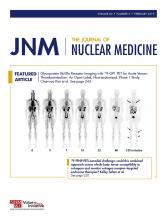TO THE EDITOR: I have read with great interest the paper by Piccardo et al. (1) and the editorial by Ceci et al. (2) recently published in your journal.
After a careful analysis of the published data, some comments seem necessary.
First, a specific 18F-choline acquisition protocol would improve the detection of recurrent prostate cancer, either for prostatic fossae or for lymph nodes. PET acquisition at only 20 min after 18F-choline injection, as reported by the authors (2), cannot be considered as a standard. In a recent review, 21 of 29 (72%) studies that focused on 18F-choline PET or PET/CT reported a late (after 60 min) whole-body scan, whereas only 8 of 29 (28%) reported acquisition at 10–15 min after tracer injection (3). In our recent experience (4) in 75 patients who underwent both an early static and a late whole-body acquisition, we found that in the case of low prostate-specific antigen levels (<2 ng/mL), early 18F-choline PET/CT scans detected recurrent disease in prostatic fossae in 15 subjects. Conversely, late images were positive in only 4 patients. Therefore, in the case of prostatic fossae recurrence, a specific acquisition protocol would be useful to improve the detection rate up to 70%. Furthermore, Oprea-Lager et al. (5) reported that a single-time-point SUV measurement 30 min after injection was a reasonable alternative for predicting the enlarged pelvic lymph nodes. However, no dedicated European guidelines are currently available for 18F-choline PET/CT examination.
Second, the authors did not report any data about 64CuCl2 acquisition (early; after 4 h; or late, after 24 h) for the interpretation of the images. This information would be useful for the repeatability of the study and also for understanding the correct scheduling of patients.
Third, the comments by Ceci et al. (2) are mainly focused on the comparison between 64CuCl2 and prostate-specific membrane antigen (PSMA)–based radiopharmaceuticals. Because most of the available data about PSMA-directed PET use 68Ga-PSMA-11—a radiopharmaceutical agent with a urinary excretion—there is a loss of information for prostatic fossae recurrence. A study performed by Uprimny et al. (6) reported that when early (after 4–8 min) and late (after 60 min) 68Ga-PSMA-11 PET/CT were used, an early 68Ga-PSMA-11 scan was able to identify the presence of prostatic fossae recurrence in 50 patients, with a gain of detection rate more than 50% than late acquisition. Again, the acquisition protocol is useful for the correct interpretation of PET/CT findings.
In our opinion, the comparison between 64CuCl2 and 68Ga-PSMA-11 or 18F-fluciclovine is mandatory, however:
A specific endpoint should be drawn, in order to assess the impact on the patients’ management and consequent survival rather than only detection rate.
A final pathology as a gold standard should be recommended in order to solve the problematic gap between imaging and the pure biochemical recurrence and to prove the new tracers’ reliability. However, it should be recalled that salvage lymph node dissection is still experimental and transrectal ultrasound–guided biopsy of the vescico-urethral anastomosis is no longer recommended by the European Association Urology (EAU) and National Institute for Health and Care Excellence (NICE) guidelines.
However, although 64CuCl2 has a long half-life, its image resolution is significantly better than that of 11C and 68Ga (7). This characteristic has an important benefit in the identification of small areas of prostate cancer recurrence, particularly in the case of local recurrence after radical prostatectomy.
Footnotes
Published online Aug. 16, 2018.
- © 2019 by the Society of Nuclear Medicine and Molecular Imaging.







